A New Look for a Legal Management
Getting Started
Leader in the Legal Field
Before we start, to comply with my non-disclosure agreement, I have omitted confidential information in this case study. All information is my own and does not necessarily reflect the views of Thomson Reuters.
Thomson Reuters is a global leader in smart solutions and information for businesses and professionals, combining intelligence, technology, and human expertise to deliver reliable answers that support management and critical decisions in the markets of Foreign Trade, Accounting, Law, and Taxation.
Legal One is one of its products that not only improves law firms’ litigation management but also offers automated calculation of procedural deadlines, provision for success or loss, issuance of fee invoices, and integrated receipts with the municipality, among many other benefits.
Legal One is the legal solution that fits their reality of the attorney’s offices that ensures efficiency and productivity automatically to evolve legal practice.
Context
Huge Impact on People's Lives
If we consider that the global legal services market size was approximately $860 billion in 2023, with the American law firm market alone generating revenues of $397 billion.
We can see that the growth of applied technology plays a significant role not only in capturing market share but also in demonstrating the effects of its adoption on productivity gains for law firms and legal departments, public bodies (such as the Judiciary), and society as a whole, through greater efficiency and expediency in resolving legal issues.
The global legal services market has been significantly impacted by the advancement of technology. For example, the automation of routine tasks, such as legal document review, has increased the operational efficiency of law firms and legal departments.
Furthermore, technology is enabling the development of data analysis tools and artificial intelligence that assist in legal research, predicting judicial outcomes, and identifying patterns in large datasets, which can increase the accuracy and effectiveness of legal advice.
My Role
A Team of Experts
Sensorama Design has an incredible cultural onboarding program that causes an immersion of the company’s values. This promotes reception and integration between people and working with high-level professionals provides security in project development. One of these teams was composed of amazing people such as Gui Ramos as UX Leader, Henrique Simões as a UX Researcher and Felipe Marchiori as an Interface Designer and me as a UX Designer.




As an integrated team, it is easy to seek transformation through design to understand users and their real-life contexts to bring clarity to business choices and decisions.
In this case study, I will show you how we have achieved this goal through the work steps that guided us to effective delivery to the customer.
The Challenge
Update the Software
The consultancy proposal was to conduct UX Research and Product Design with the aim of conducting a discovery phase through qualitative research within the Legal One user universe and digital product prototyping focused on improving usability and experience.
Thus, the goal was to understand the perceived value by users and how to enhance this value within the digital product usage journey.
Kicking-off
To understand customer briefing, we have made a series of collaborative workshops to understand the vision and expectations of results we should meet. We left with an action plan properly aligned. Thus, we had an initial and macro view of the project and were clear about what the expected outputs, the outcomes and the impact would be.
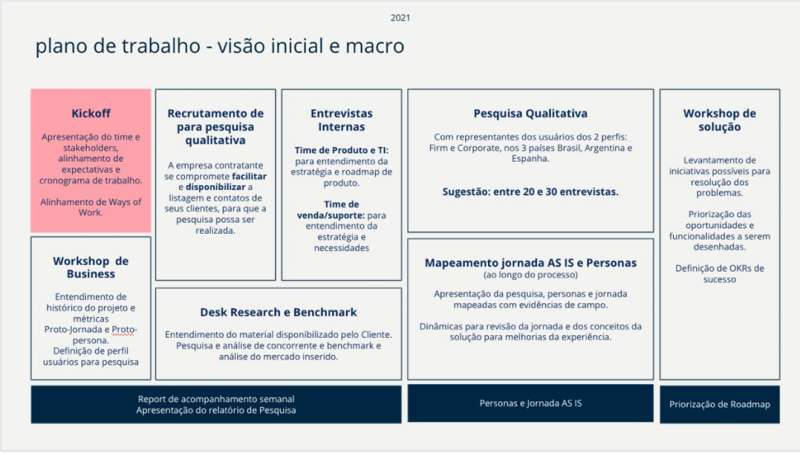
Discoveries
Empathy for Understanding
After kicking with stakeholders through collaborative workshops, we defined project goals. With these definitions, we are straightforward to meet the perspectives of users. For this, we perform the following techniques:
User Interview
After tactical alignment with the customer, research began to take shape. For this:
- We made a recruitment plan;
- We conducted internal interviews with stakeholders;
- We conducted interviews with representatives of users.
With qualitative research it was possible to understand deeply how users feel when using our customer’s product.

Competitive Analysis
To understand the market and the product, we did a competitive analysis using two techniques: benchmark and heuristic analysis. We did a competitive analysis to understand how we can learn from competitors.

From a technique we learn from competitors. From the second, we understand how the software is positioning themselves in the market compared to these competitors analyzed while prioritizing current product usability problems (as is).
Information Architecture
Then my task was to work on the information architecture to understand product interaction. With this, in addition to analyzing the structure with a sitemap, we also made a card sorting to understand the mental model of users.
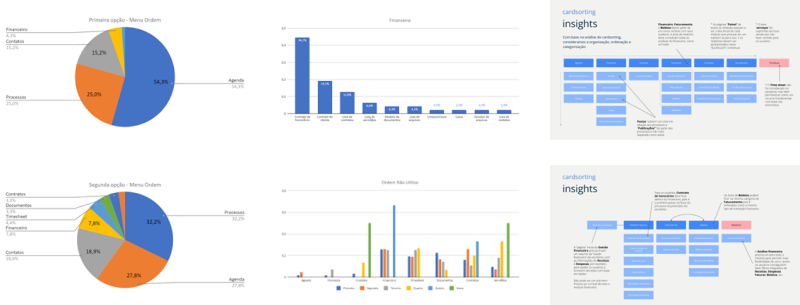
We identified conflicting areas on terminology and content organization, considering the flow of a legal process according to their specificities.
Divergent Insights
We carry out a User Journey to have an overview of all touchpoints and frictions to generate insights. We conducted a user journey to have an overview of all contact points and friction to generate insights.
Through this output, we are able to support the creation of more efficient solutions for customer use experience. The idea is to understand in what aspects you can offer better service or service and enhance the relationship with the consumer.
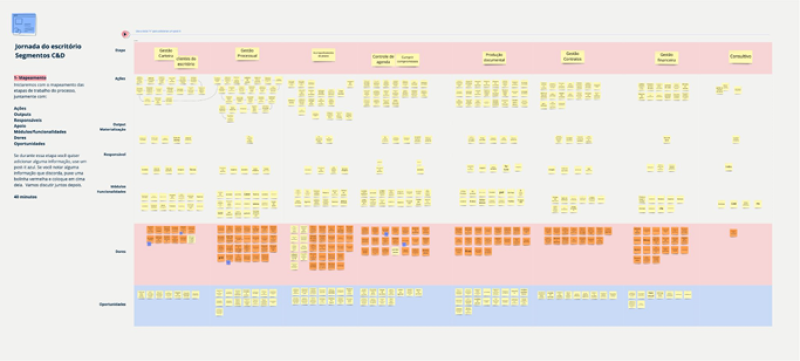
Converging Insights
There were many points to be considered, analyzed and consolidated. As a result, a series of improvement opportunities for the product were generated. An Opportunities Solution Tree visually representing the connection between results, opportunities and solutions was created.

The starting point for the team to develop the spirit of result and from it we map the opportunities that could directly impact it.
The Solution
Opportunities
With a specified contract, the best way to work and guarantee deliveries on time was to use the Lean UX method, in which we projected, bordered, and evaluated iteratively. This approach was a critical success factor as it allowed us to develop the product through a less extensive documentation process, with transparent communications in the daily construction of the product among participating teams (design and developers).
Leaningly, we propose design solutions through prototypes in the fillets, we perform usability tests with users and evaluate the answers. If there was a need for corrections, they were made. With everything verified, we move to the functional specification.
Prototypes
Prototypes played a crucial role in our design process, allowing you to view and test ideas interactively before final implementation. They provided a tangible product representation, helping to identify usability problems, navigation flow and visual design. With a customer design system, the reuse of components helped us create consistent and scalable prototypes to project a cohesive product in all interfaces.
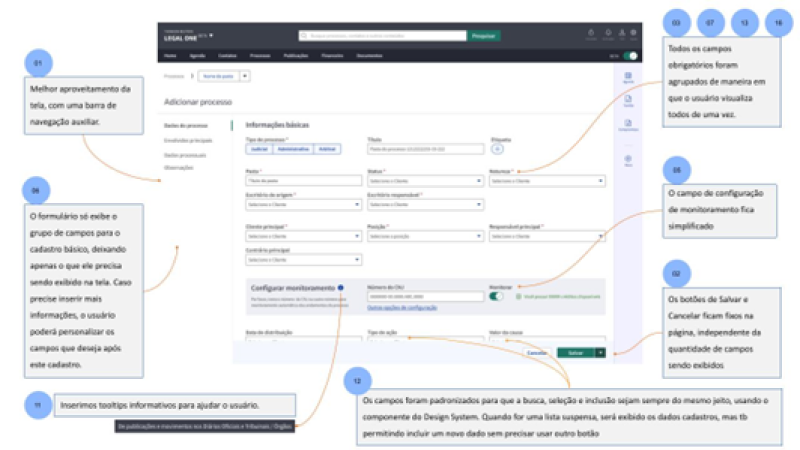
Usability Tests
Identification of possible improvements in the project was possible with the participation of users. By observing them interacting with the product, we were able to detect friction points, navigation difficulties and areas of confusion that were transformed into valuable insights.
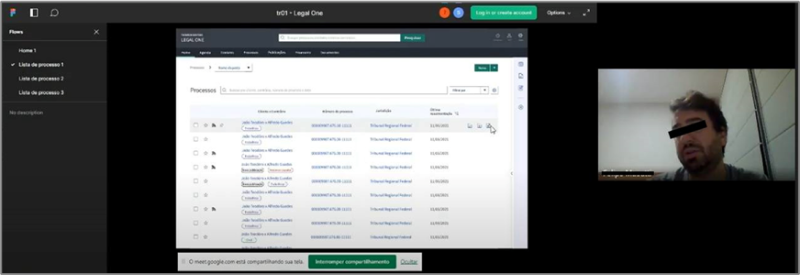
Hand-off
Since the interfaces were evaluated by users, we technically document all navigation through functional specification, signaling the behaviors of each interactive component in the interface. In this way, we guarantee the fidelity of the original design and avoid misunderstanding through effective communication.
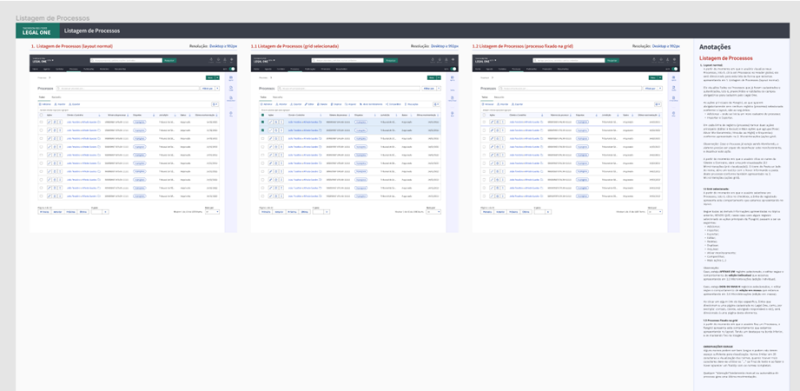
Release Plan
In addition to all design deliveries, the customer also requested help to create a product update launch plan to reduce the impact on satisfaction during the interface update process for the new version. This plan has established a detailed strategy for incremental delivery of functionality as well as the priority order of functionality based on the value added to the user and business needs.
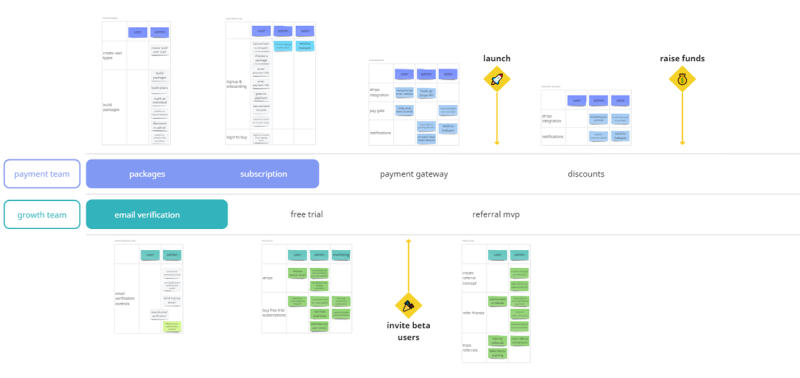
Learnings
From Task to Improvements
#1 Users Collaboration
The importance of user participation from the beginning once again proved to be a benefit in product development. This has allowed insights on your needs, preferences and expectations, guiding our design decisions more accurately. This is nothing new in the design field, it is a strong proof of having users around.
#2 Interaction Matters
In a scenario oriented by efficiency and productivity, it seemed a way to try to reduce the amount of clicks as much as possible. However, along the way, we realize another perspective, with this statement of one of the participants:
“No matter how much clicks need to perform a task as long as they make sense.”
This made us clear that the context and logic behind clicks are equally important as long as they are clear, consistent and predictable for the user.
#3 Iterative Design
Revision, adjusting and enhancely constant based on user feedback on usability tests have released to propose solutions and test them more safely. Thus, we respond flexibly to needs as emerged, ensuring that the final product truly meets user expectations and requirements.
Thanks
Alignment for the Future
In the Legal One project, Sensorama stood out for its ability to assemble a team of incredible professionals to find the ideal solution for a chronic need. Simplifying legal processes while adhering to regulations and legislation was a significant challenge given a closed scope contract. However, maturity ensured excellence in service delivery.
Let’s Work Together
Get in touch to talk about design, the universe and everything.